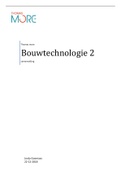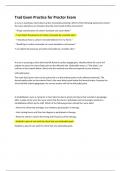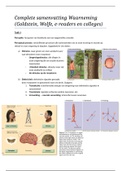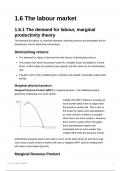CH2: TUBERCULOSIS & MYCOBACTERIA
INTRODUCTION
Mycobacterium tuberculosis is one of the species that belong to the genus mycobacterium. This is the only genus
in the family of Mycobacteriaceae, which is part of the suborder Corynebacterinae. Other genera/species that
also belong to this suborder: Corynaebacterium and Nocardia.
THE BACTERIA
MYCOBACTERIAL CELL WALL
Typical about mycobacteria is that they have a very thick and lipid-rich cell wall. It is very ridged and solid lipid-
rich cell wall which makes them have some specific characteristics. Mycolic acid and lipoarabinomannan (LAM)
are important for the diagnosis also of mycobacterial diseases.
Note: you do not need to know all the substances (only LAM and mycolic acid)
What are the consequences of the thick cell wall?
- Acid-fast character: when you have mycobacteria in a sample and you apply a staining, when you do a
de-staining using acid alcohol, the mycobacteria will retain the dye in their cell wall despite this acid-
alcohol destaining (other organisms: will release the dye!)
o Is used in the diagnostic application of microscopy: only mycobacteria will be stained
o Note: also some Nocardia and Corynaebacteria have some acid-fastness but to a minor extent
- Lipoarabinomannan (LAM): useful for the lateral flow assay diagnostics
- Other consequences (seen further in the lecture):
o Bacilli are lipophilic → like to form biofilms
▪ Biofilms can be formed on surgical instruments e.g. for liposuction/bronchoscopy
▪ Biofilm makes that it is hard to get rid of the bacilli
o Decreased penetration of antibiotics
LEPROSY
Leprosy is caused by Mycobacterium leprae.
- Bacterium is not instinct: still important
o Even in 2018: > 200 000 cases worldwide
- Relatively wide-spread over the world nowadays:
o hotspot countries (Brazil, India, Bangladesh, Nepal, Congo)
▪ Even in these countries: focal endemicities
o In the past: also for example seen in Belgium
, - Leprosy is also occurring in small children even in countries where there is a good leprosy control
program: indicates that transmission is still ongoing
o Not completely clear transmission but important role of aerosols and inhalation infection of
the nose
Clinical presentation
- Mostly skin affected: laprae bacilli prefer a low temperature
- Affinity for nerve cells: loss of feeling on skin surface occurs
- Continuum of disease presentation: numbness on specific spots → hypopigmented spots → lesions
Diagnosis and treatment
- Diagnosis:
o Clinically: numbness and lesions
o Bacteriologically: qPCR and histopathology
▪ No in vitro growth possible of M. laprae: 32 days replication time
• Extremely slow
• Reason: M. laprae compared to other mycobacteria has lost a lot of genes
that are needed to build the cell wall and so on
→ can still do it but at much lower rate
→ probably lost genes that are needed to survive in other environment
like in in vitro growth cultures
- Treatment: multidrug regimen (6-24 months)
o Dapsone
o Rifampicin
o Clofazimine
➔ Effective treatment
Note: if people already have injuries (e.g. they burn themselves while cooking but don’t feel this), these can not
be entirely cured using the multidrug treatment. SO leprosy is a curable disease so not directly a lethal disease
but it is a chronic disease that at the end can lead to death because of the complications.
BURULI ULCER
Buruli ulcer is caused by Mycobacterium ulcerans.
- 3rd most important mycobacterial disease
- Geographically restricted: source of infection = environment
o Focal endemicity: West-Africa, Australia, few cases in other countries (China, Peru)
▪ Stabilized in most countries
o M. ulcerans is present in the environment in areas with stagnant water
▪ People having small injuries go in the water
▪ M. ulcerans can passively penetrate in the open wounds
Clinical presentation
- Mostly skin affected: preference low temperature
o Toxin (= mycolactone)
▪ Genes are on plasmid (uncommon in mycobacteria)
▪ Characteristics of the toxin:
• Undermines skin: also oedema over wider spread locations under the skin
• anti-inflammatory action → the ulcers are painless!
- Plaques → nodules → ulcers
, - Scarring/complications → deformities → disabilities
o Not ulcers itself have a long-term effect but it are the complications/deformities cause
disabilities
o Lot of economical loss: patient cannot work/function anymore
Diagnosis and treatment
- Diagnosis:
o Clinically: differential diagnosis is complicated (undermined skin)
▪ Bacteriological confirmation is needed
o Bacteriologically: qPCR, microscopy & culture (weeks to months)
▪ qPCR for early diagnosis
- Treatment:
o Small lesions:
▪ rifampicin + clarithromycin/moxifloxacin (4-8 weeks)
▪ also wound and lymphoedema management possible
o Larger lesions: surgery
▪ Mainly debridement and skin grafting
So it is not a lethal disease but it is causing a high morbidity and sometimes long-term disabilities if not treated
properly.
OTHER NON-TUBERCULOUS MYCOBACTERIA (NTM)
There are a lot of different species of mycobacteria been described. The majority of them are present in the
environment but don’t cause disease. Some of them can occasionally cause disease, usually in people that
already have some immunity problems.
- Pulmonary: most frequent (in countries with lower TB endemicity)
o M. avium, M. kansasii, M. intracellulare
▪ M. avium causes bird tuberculosis but can also affect pigs and humans
- Cutaneous: worldwide
o M. marinum, M. ulcerans, M. chelonae
▪ M. marinum: causes fish tank disease
• Fish can be infected by M. marinum and can develop ulcers
o If people with fish tank at home go with their hands that have
injury in the water: people can develop ulcer
• Closely related to M. ulcerans but does not have the plasmid and thus not
the toxin
▪ M. chelonae: causes ulcers following liposuction
• Bacilli are lipophilic, they form biofilms on the tools they use to perform
liposuction (or also bronchoscopy)
= other consequence of the lipid cell wall!
• Biofilms: difficult to get rid of the bacilli → protect each other in the biofilm
o Disinfectants: you have to apply them for a longer time to kill the
bacteria (compared to e.g. E. Coli)
→ even when you think you are cleaning the tools correctly, you
will introduce the mycobacteria in the patient/client
- Lymph nodes, articulations, muscles
o M. avium, M. ulcerans, M. intracellulare
- Generalised disease: immunocompromised patients
o M. avium
INTRODUCTION
Mycobacterium tuberculosis is one of the species that belong to the genus mycobacterium. This is the only genus
in the family of Mycobacteriaceae, which is part of the suborder Corynebacterinae. Other genera/species that
also belong to this suborder: Corynaebacterium and Nocardia.
THE BACTERIA
MYCOBACTERIAL CELL WALL
Typical about mycobacteria is that they have a very thick and lipid-rich cell wall. It is very ridged and solid lipid-
rich cell wall which makes them have some specific characteristics. Mycolic acid and lipoarabinomannan (LAM)
are important for the diagnosis also of mycobacterial diseases.
Note: you do not need to know all the substances (only LAM and mycolic acid)
What are the consequences of the thick cell wall?
- Acid-fast character: when you have mycobacteria in a sample and you apply a staining, when you do a
de-staining using acid alcohol, the mycobacteria will retain the dye in their cell wall despite this acid-
alcohol destaining (other organisms: will release the dye!)
o Is used in the diagnostic application of microscopy: only mycobacteria will be stained
o Note: also some Nocardia and Corynaebacteria have some acid-fastness but to a minor extent
- Lipoarabinomannan (LAM): useful for the lateral flow assay diagnostics
- Other consequences (seen further in the lecture):
o Bacilli are lipophilic → like to form biofilms
▪ Biofilms can be formed on surgical instruments e.g. for liposuction/bronchoscopy
▪ Biofilm makes that it is hard to get rid of the bacilli
o Decreased penetration of antibiotics
LEPROSY
Leprosy is caused by Mycobacterium leprae.
- Bacterium is not instinct: still important
o Even in 2018: > 200 000 cases worldwide
- Relatively wide-spread over the world nowadays:
o hotspot countries (Brazil, India, Bangladesh, Nepal, Congo)
▪ Even in these countries: focal endemicities
o In the past: also for example seen in Belgium
, - Leprosy is also occurring in small children even in countries where there is a good leprosy control
program: indicates that transmission is still ongoing
o Not completely clear transmission but important role of aerosols and inhalation infection of
the nose
Clinical presentation
- Mostly skin affected: laprae bacilli prefer a low temperature
- Affinity for nerve cells: loss of feeling on skin surface occurs
- Continuum of disease presentation: numbness on specific spots → hypopigmented spots → lesions
Diagnosis and treatment
- Diagnosis:
o Clinically: numbness and lesions
o Bacteriologically: qPCR and histopathology
▪ No in vitro growth possible of M. laprae: 32 days replication time
• Extremely slow
• Reason: M. laprae compared to other mycobacteria has lost a lot of genes
that are needed to build the cell wall and so on
→ can still do it but at much lower rate
→ probably lost genes that are needed to survive in other environment
like in in vitro growth cultures
- Treatment: multidrug regimen (6-24 months)
o Dapsone
o Rifampicin
o Clofazimine
➔ Effective treatment
Note: if people already have injuries (e.g. they burn themselves while cooking but don’t feel this), these can not
be entirely cured using the multidrug treatment. SO leprosy is a curable disease so not directly a lethal disease
but it is a chronic disease that at the end can lead to death because of the complications.
BURULI ULCER
Buruli ulcer is caused by Mycobacterium ulcerans.
- 3rd most important mycobacterial disease
- Geographically restricted: source of infection = environment
o Focal endemicity: West-Africa, Australia, few cases in other countries (China, Peru)
▪ Stabilized in most countries
o M. ulcerans is present in the environment in areas with stagnant water
▪ People having small injuries go in the water
▪ M. ulcerans can passively penetrate in the open wounds
Clinical presentation
- Mostly skin affected: preference low temperature
o Toxin (= mycolactone)
▪ Genes are on plasmid (uncommon in mycobacteria)
▪ Characteristics of the toxin:
• Undermines skin: also oedema over wider spread locations under the skin
• anti-inflammatory action → the ulcers are painless!
- Plaques → nodules → ulcers
, - Scarring/complications → deformities → disabilities
o Not ulcers itself have a long-term effect but it are the complications/deformities cause
disabilities
o Lot of economical loss: patient cannot work/function anymore
Diagnosis and treatment
- Diagnosis:
o Clinically: differential diagnosis is complicated (undermined skin)
▪ Bacteriological confirmation is needed
o Bacteriologically: qPCR, microscopy & culture (weeks to months)
▪ qPCR for early diagnosis
- Treatment:
o Small lesions:
▪ rifampicin + clarithromycin/moxifloxacin (4-8 weeks)
▪ also wound and lymphoedema management possible
o Larger lesions: surgery
▪ Mainly debridement and skin grafting
So it is not a lethal disease but it is causing a high morbidity and sometimes long-term disabilities if not treated
properly.
OTHER NON-TUBERCULOUS MYCOBACTERIA (NTM)
There are a lot of different species of mycobacteria been described. The majority of them are present in the
environment but don’t cause disease. Some of them can occasionally cause disease, usually in people that
already have some immunity problems.
- Pulmonary: most frequent (in countries with lower TB endemicity)
o M. avium, M. kansasii, M. intracellulare
▪ M. avium causes bird tuberculosis but can also affect pigs and humans
- Cutaneous: worldwide
o M. marinum, M. ulcerans, M. chelonae
▪ M. marinum: causes fish tank disease
• Fish can be infected by M. marinum and can develop ulcers
o If people with fish tank at home go with their hands that have
injury in the water: people can develop ulcer
• Closely related to M. ulcerans but does not have the plasmid and thus not
the toxin
▪ M. chelonae: causes ulcers following liposuction
• Bacilli are lipophilic, they form biofilms on the tools they use to perform
liposuction (or also bronchoscopy)
= other consequence of the lipid cell wall!
• Biofilms: difficult to get rid of the bacilli → protect each other in the biofilm
o Disinfectants: you have to apply them for a longer time to kill the
bacteria (compared to e.g. E. Coli)
→ even when you think you are cleaning the tools correctly, you
will introduce the mycobacteria in the patient/client
- Lymph nodes, articulations, muscles
o M. avium, M. ulcerans, M. intracellulare
- Generalised disease: immunocompromised patients
o M. avium











